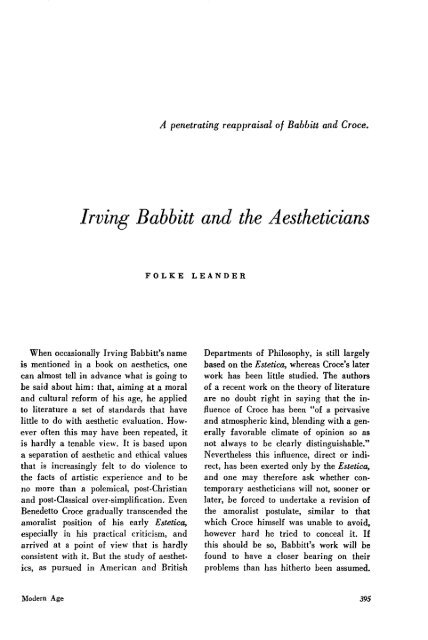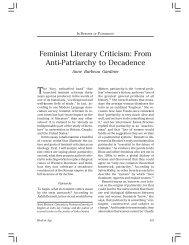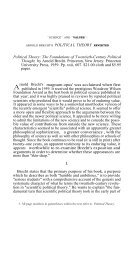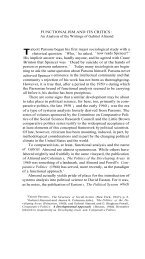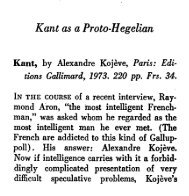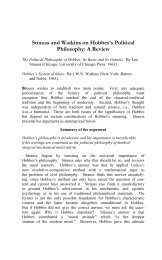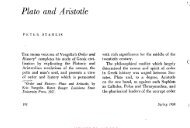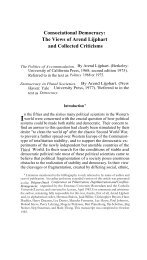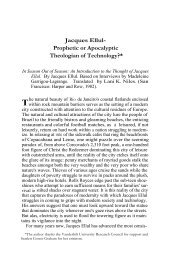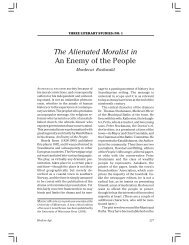Irving Babbitt the Aestheticians
Irving Babbitt the Aestheticians
Irving Babbitt the Aestheticians
Create successful ePaper yourself
Turn your PDF publications into a flip-book with our unique Google optimized e-Paper software.
A penetrating reappraisal of <strong>Babbitt</strong> and Croce.<br />
<strong>Irving</strong> <strong>Babbitt</strong> and <strong>the</strong> Aes<strong>the</strong>ticians<br />
When occasionally <strong>Irving</strong> <strong>Babbitt</strong>’s name<br />
is mentioned in a book on aes<strong>the</strong>tics, one<br />
can almost tell in advance what is going to<br />
be said about him: that, aiming at a moral<br />
and cultural reform of his age, he applied<br />
to literature a set of standards that have<br />
little to do with aes<strong>the</strong>tic evaluation. How-<br />
ever often this may have been repeated, it<br />
is hardly a tenable view. It is based upon<br />
a separation of aes<strong>the</strong>tic and ethical values<br />
that is increasingly felt to do violence to<br />
<strong>the</strong> facts of artistic experience and to be<br />
no more than a polemical, post-Christian<br />
and post-Classical over-simplification. Even<br />
Benedetto Croce gradually transcended <strong>the</strong><br />
amoralist position of his early Estetica,<br />
especially in his practical criticism, and<br />
arrived at a point of view that is hardly<br />
consistent with it. But <strong>the</strong> study of aes<strong>the</strong>t-<br />
ics, as pursued in American and British<br />
FOLKE LEANDER<br />
Departments of Philosophy, is still largely<br />
based on <strong>the</strong> Estetica, whereas Croce’s later<br />
work has been little studied. The authors<br />
of a recent work on <strong>the</strong> <strong>the</strong>ory of literature<br />
are no doubt right in saying that <strong>the</strong> in-<br />
fluence of Croce has been “of a pekasive<br />
and atmospheric kind, blending with a gen-<br />
erally favorable climate of opinion so as<br />
not always to be clearly distinguishable.”<br />
Never<strong>the</strong>less this influence, direct or indi-<br />
rect, has been exerted only by <strong>the</strong> Estetica,<br />
and one may <strong>the</strong>refore ask whe<strong>the</strong>r con-<br />
temporary aes<strong>the</strong>ticians will not, sooner or<br />
later, be forced to undertake a revision of<br />
<strong>the</strong> amoralist postulate, similar to that<br />
which Croce himself was unable to avoid,<br />
however hard he tried to conceal it. If<br />
this should be so, <strong>Babbitt</strong>’s work will be<br />
found to have a closer bearing on <strong>the</strong>ir<br />
problems than has hi<strong>the</strong>rto been assumed.<br />
Modern Age 395
If one were to summarize <strong>the</strong> basic<br />
tenets of Crocean aes<strong>the</strong>tics, <strong>the</strong> following<br />
formulae might be hazarded:<br />
Intuition is a non-intellectual mode of<br />
knowing. Knowing what? Knowing life<br />
and nature as concretely experienced. In-<br />
tuition means insight. Insight into what?<br />
Into <strong>the</strong> dynamic development of vital en-<br />
ergies.<br />
These definitions form a circuitous way<br />
of pointing to something within our experi-<br />
ence, namely <strong>the</strong> artistic imagination as a<br />
mode of insight, a kind of knowing. Most<br />
modern aes<strong>the</strong>ticians follow Croce with re-<br />
gard to <strong>the</strong> above doctrines. But let us now<br />
raise a question which modern aes<strong>the</strong>ti-<br />
cians do not raise: Can <strong>the</strong> insight be more<br />
or less profound? Are <strong>the</strong>re degrees of<br />
poetic truth, degrees of profundity in our<br />
imaginative vision of life? This question<br />
brings us into <strong>the</strong> realm of problems, where<br />
<strong>Babbitt</strong>’s contribution to aes<strong>the</strong>tics should<br />
be looked for.<br />
In his amoralist phase Croce says <strong>the</strong>re<br />
is simply art and non-art; all art is equally<br />
true, and <strong>the</strong>re are no degrees of poetic<br />
truth. <strong>Babbitt</strong>’s opposition to Croce was<br />
directed against this view; and since his<br />
was <strong>the</strong> type of mind that looks for differ-<br />
ences ra<strong>the</strong>r than agreements, he failed to<br />
notice in Croce <strong>the</strong> presence of ano<strong>the</strong>r<br />
trend of thought, much closer to his own.<br />
<strong>Babbitt</strong> maintained that <strong>the</strong>re is a differ-<br />
ence between <strong>the</strong> poetry which shows us<br />
<strong>the</strong> superficial aspects of life and that<br />
which gives us profound insight into life<br />
as subjected to a moral world-order. The<br />
highest type of art, according to this view,<br />
is art which gives us insight into <strong>the</strong> moral<br />
substance of life. There is o<strong>the</strong>r art, valu-<br />
able in its own way, although it does not<br />
go beneath <strong>the</strong> surface of life and <strong>the</strong>refore<br />
does not reach <strong>the</strong> moral core of reality<br />
What is <strong>the</strong> “moral substance of life”?<br />
Space does not permit me to go into Bab-<br />
bitt’s moral philosophy, nor is this neccs-<br />
sary for a comparison with Croce, since<br />
<strong>the</strong> latter’s view of <strong>the</strong> nature of <strong>the</strong> moral<br />
conscience, as expounded in his Filosojia<br />
della pratica, is in essentials identical<br />
with <strong>Babbitt</strong>’s. Moreover, <strong>the</strong> whole con-<br />
ception of a moral world-order is familiar<br />
to anyone who knows his Plato or Aristotle.<br />
For <strong>the</strong> purposes of a comparison we may<br />
state that <strong>Babbitt</strong> and Croce were agreed -<br />
as to <strong>the</strong> reality of a “higher will,” or<br />
moral world-order, and that <strong>the</strong>ir disagree-<br />
ment-more partial than <strong>Babbitt</strong> believed<br />
---concerns <strong>the</strong> relation of art to this world-<br />
order. In his amoralist phase Croce thinks<br />
that intuition always has <strong>the</strong> same value,<br />
and that no artistically relevant distinc-<br />
tions can be based upon what is intuited.<br />
Supreme instances of art penetrating <strong>the</strong><br />
moral substance of life are, according to<br />
<strong>Babbitt</strong>, <strong>the</strong> dramas of Aeschylus and<br />
Sophocles, <strong>the</strong> myths of Plato, <strong>the</strong> poetry<br />
of Dante. But <strong>Babbitt</strong> also taught that this<br />
moral substance of life is inexhaustible. It<br />
cannot be locked up in a formula. It is<br />
infinitely faceted, showing some new aspect<br />
from whatever point you approach it. It 1s<br />
primarily through his imagination that<br />
man has access to <strong>the</strong> moral element of life:<br />
<strong>the</strong> insights of <strong>the</strong> Greek poets preceded<br />
<strong>the</strong> conceptual formulations of <strong>the</strong> Greek<br />
philosophers, just as <strong>the</strong> parables of Christ<br />
preceded <strong>the</strong> Scholastic elaboration of eth-<br />
ics. If one overlooks <strong>the</strong> cognitive function<br />
of <strong>the</strong> imagination as such, if one believes<br />
that <strong>the</strong> moral element of poetry is simply<br />
an importation into it of intellectual reflec-<br />
tions, one falls into <strong>the</strong> error of intellect-<br />
ualism, as did <strong>the</strong> neo-Classical <strong>the</strong>orists<br />
of “reason” controlling “imagination.”<br />
Since <strong>the</strong> imagination as such has varying<br />
degrees of cognitive insight, works of art<br />
may be ranked according to <strong>the</strong> fullness<br />
and clarity of such perception. <strong>Babbitt</strong>’s<br />
contribution to aes<strong>the</strong>tics was a doctrine<br />
of <strong>the</strong> degrees of poetic trzith, thus liberat-
ing Classicism from <strong>the</strong> error of intellect-<br />
ualism and freeing aes<strong>the</strong>tics from sub-<br />
servience to Romantic and “Realist” amor-<br />
alism.<br />
The concept of poetic truth <strong>the</strong>refore<br />
turns out to be much more complex than<br />
might be inferred from <strong>the</strong> over-simplified<br />
accounts of it given by recent aes<strong>the</strong>ticians.<br />
John Hospers, in his competent book on<br />
Meaning and Truth in <strong>the</strong> Arts, takes us no<br />
fur<strong>the</strong>r than to a distinction between truth-<br />
about and truth-to. If you write a book on<br />
London, full of facts and statistics, you<br />
give truth-about London. If you write a<br />
poem on London, this poem may be true-to<br />
your experience of life as lived in that city.<br />
Poetry is true-to our feelings as evoked by<br />
concrete experience of things and events.<br />
It is true-to our emotional reactions to <strong>the</strong><br />
life in which we participate. Poetic truth,<br />
Hospers would agree with <strong>the</strong> early Croce,<br />
is simply adequate expression. This analy-<br />
sis, <strong>Babbitt</strong> would object, is no doubt cor-<br />
rect as far as it goes, but it leaves unex-<br />
plored an entire dimension of our poetic<br />
experience. There is, he would explain,<br />
much more to be said in answer to <strong>the</strong><br />
question: true-to what? Poetry may be<br />
true-to moods and states of mind not inte-<br />
grated into a complete personality and<br />
hence only conducive to superficial views<br />
of reality. Poetry may be true-to <strong>the</strong> whole<br />
personality, including <strong>the</strong> ethical self; it<br />
may be true-to <strong>the</strong> “human heart,” and<br />
what is deepest in <strong>the</strong> human heart, and<br />
thus bring us closer to real life. Poetic<br />
truth is dependent on what is being ex-<br />
pressed. To put it in terms of intuition:<br />
<strong>the</strong>re is more and more poetic truth, <strong>the</strong><br />
more our intuition penetrates our experi-<br />
ence of life and manages to lay hold of its<br />
moral laws-laws that are not created by<br />
us for <strong>the</strong> simple reason that <strong>the</strong>y are <strong>the</strong><br />
immanent laws of our creative activity,<br />
inescapable and not subject to our caprice.<br />
O<strong>the</strong>r philosophers deal with <strong>the</strong> prob-<br />
lem in <strong>the</strong> same one-sided fashion as does<br />
Hospers. Ernst Cassirer, for instance, sum-<br />
marizes his aes<strong>the</strong>tics as follows:<br />
In science we try to trace phenomena<br />
back to <strong>the</strong>ir first causes, and to general<br />
laws and principles. In art we are ab-<br />
sorbed in <strong>the</strong>ir immediate appearance,<br />
and we enjoy this appearance to <strong>the</strong><br />
fullest extent in all its richness and vari-<br />
ety. Here we are not concerned with <strong>the</strong><br />
uniformity of laws but with <strong>the</strong> multi-<br />
formity and diversity of intuitions. Even<br />
art may be described as knowledge, but<br />
art is knowledge of a peculiar and spe-<br />
cific kind. We may well subscribe to <strong>the</strong><br />
observation of Shaftesbury that “all<br />
beauty is truth.” But <strong>the</strong> truth of beauty<br />
does not consist in a <strong>the</strong>oretical descrip-<br />
tion and explanation of things; it con-<br />
sists ra<strong>the</strong>r in <strong>the</strong> “sympa<strong>the</strong>tic vision”<br />
of things. The two views of truth are in<br />
contrast with one ano<strong>the</strong>r, but not in<br />
conflict or contradiction.<br />
Cassirer says that <strong>the</strong>re is such a thing<br />
as intuitive insight, but he forgets that this<br />
insight may vary in profundity. “Art is<br />
not an imitation but a discovery of real-<br />
ity,” he goes on to say. A discovery of<br />
more or less? He gives no answer to that<br />
question. Irwin Edman describes <strong>the</strong> con-<br />
trast between intellect and intuition as fol-<br />
lows :<br />
There is a poetic, dramatic, moral<br />
truth, truth that is <strong>the</strong> expression of a<br />
fact as humanly encountered or experi-<br />
enced [What sort of facts?], not a neu-<br />
tral description of its status in <strong>the</strong> total<br />
uncaring context of things. The arts<br />
give <strong>the</strong> truth of things [Wh<br />
“things”?] as <strong>the</strong>y have an impact in<br />
<strong>the</strong> feelings and imaginations of men.<br />
Edman, too, omits <strong>the</strong> question about<br />
<strong>the</strong> profundity of <strong>the</strong> level on which <strong>the</strong><br />
concrete encounter takes place. What en-<br />
counters what?-that is <strong>the</strong> problem which<br />
he does not raise. Susanne Langer deals<br />
Modern Age 397
adequately with <strong>the</strong> truth-value of music.<br />
It is not just “expression,” she says, mean-<br />
ing an immediate outburst of feeling-a<br />
<strong>the</strong>ory which she erroneously attributes to<br />
Croce. Music, she says, is not as simple as<br />
that, for it gives knowledge as well:<br />
It expresses <strong>the</strong> composer’s knowledge<br />
of human feelings.<br />
Music is <strong>the</strong> formulation and repre-<br />
sentation of emotions, moods, mental<br />
tensions and resolution-a source of<br />
insight.<br />
It makes emotive contents conceivable<br />
so that we can envisage and understand<br />
<strong>the</strong>m.<br />
A composer articulates subtle com-<br />
plexes of feeling that language cannot<br />
even name.<br />
Musicality is often regarded as an<br />
essentially unintellectual trait. Perhaps<br />
that is why musicians, who know it is<br />
<strong>the</strong> prime source of <strong>the</strong>ir mental life<br />
and <strong>the</strong> medium of <strong>the</strong>ir clearest insight<br />
into humanity, so often feel called upon<br />
to despise <strong>the</strong> more obvious forms of<br />
understanding.<br />
Insight is <strong>the</strong> gift of music; in very<br />
naive phrase, a knowledge of “how feel-<br />
ings go.”<br />
She has also an explanation of <strong>the</strong> truth-<br />
value of music. The tones are arranged in<br />
dynamic patterns that are isomorphic with<br />
<strong>the</strong> dynamic patterns of vital energies in<br />
our practical life. Hence music may serve<br />
as a symbolic picture. But she does not<br />
mention that <strong>the</strong> dynamic pattern of musi-<br />
cal energies may be that of an ethical soul<br />
controlling expansive forces. Irwin Edman<br />
has a great deal to say about <strong>the</strong> truth of<br />
dees, <strong>the</strong>y put into canvas a vision of<br />
what life essentially meant to <strong>the</strong>m.<br />
But are all interpretations of what life<br />
means equally profound? Are imaginative<br />
visions of life always equally true? No<br />
answer. Edman continues:<br />
A mood half articulate and half rec-<br />
ognized in its confused recurrence be-<br />
comes, as it were, clarified forever in a<br />
poem or a novel or a drama.<br />
But how far into reality does that mood<br />
take us? Edman does not raise <strong>the</strong> ques-<br />
tion. Susanne Langer also has a good pas-<br />
sage about <strong>the</strong> truth of literature:<br />
The “livingness” of a story is really<br />
much surer, and often greater, than that<br />
of actual experience. Life itself may, at<br />
times, be quite mechanical and unper-<br />
ceived by those who live it.<br />
And Edman is perhaps even more lucid<br />
when, speaking about a well-known poem,<br />
he expresses <strong>the</strong> same idea as follows:<br />
Thousands of inarticulate men and<br />
women have felt that emotion about <strong>the</strong>ir<br />
beloved, but in that sonnet of Shake-<br />
speare’s <strong>the</strong>y find <strong>the</strong>ir common emo-<br />
tion rendered with uncommon and vital-<br />
izing felicity. A poem of love may teach<br />
<strong>the</strong>m by its own instant and luminous<br />
reality what <strong>the</strong> reality of <strong>the</strong>ir own<br />
love is.<br />
This is excellently said. But, in <strong>the</strong><br />
name of common sense, cannot poetry give<br />
people largely illusory ideas about <strong>the</strong>ir<br />
own emotions? Emma Bovary was more<br />
imaginative than most people, but her<br />
imagination hardly reached down to <strong>the</strong><br />
works of art: deeper strata of reality. It is strange - that<br />
all modern, supposedly scientific, aes<strong>the</strong>ti-<br />
One hears more than an arrangement<br />
cians should still follow in <strong>the</strong> wake of <strong>the</strong><br />
of sounds in Beethoven’s Fifth Symphony.<br />
one hears he comment of a<br />
nineteenth century Romantics, thus forgetgreat<br />
spirit on <strong>the</strong> world in which it ting <strong>the</strong> obvious fact that <strong>the</strong> imagination<br />
lives. In Rembrandt’s pictures of old may also give US superficial notions about<br />
rabbis, or El Greco’s of Spanish gran- life. And it is even more strange that <strong>the</strong>y<br />
398 Fall 1960
are perfectly well aware of it in o<strong>the</strong>r con-<br />
nections. Susanne Langer is surprised that<br />
such an imaginative creature as man should<br />
have been able to survive on this earth.<br />
Modern aes<strong>the</strong>ticians, following Croce,<br />
interpret <strong>the</strong> term “catharsis” as referring<br />
merely to <strong>the</strong> act of expression or intuition,<br />
quite apart from what is expressed or in-<br />
tuited. As Cassirer puts it :<br />
Our passions are no longer dark and<br />
impenetrable powers; <strong>the</strong>y become, as<br />
it were, transparent. . . But <strong>the</strong> image<br />
of a passion is not <strong>the</strong> passion itself. . . .<br />
If we accept this view of art we can<br />
come to a better understanding of a<br />
problem first encountered in <strong>the</strong> Aristo-<br />
telian <strong>the</strong>ory of catharsis. . . . In this<br />
world all our feelings undergo a sort of<br />
transubstantiation with respect to <strong>the</strong>ir<br />
essence and <strong>the</strong>ir character.<br />
According to <strong>Babbitt</strong>, on <strong>the</strong> o<strong>the</strong>r hand,<br />
LL<br />
catharsis” refers to our experience when<br />
<strong>the</strong> imagination penetrates <strong>the</strong> moral substance<br />
of reality. All art does not result in<br />
this catharsis, he holds.<br />
As <strong>Babbitt</strong> pointed out, <strong>the</strong> notion that<br />
all products of <strong>the</strong> imagination have an<br />
equal amount of poetic truth is of fairly<br />
recent origin; it goes back to <strong>the</strong> early<br />
Romantics. Before that <strong>the</strong>re had been a<br />
distinction between unrestrained imagination<br />
(which was at best regarded as idyllic<br />
play, at worst as foolish “conceit”) and an<br />
imagination governed by “reason.” The<br />
Classical critics, <strong>Babbitt</strong> held, were right<br />
in insisting upon <strong>the</strong> necessity of a distinction,<br />
though wrong in <strong>the</strong>ir manner of stating<br />
it. And whereas <strong>the</strong> Classical revival in<br />
twentieth century France remained entangled<br />
in <strong>the</strong> old intellectualist error-you<br />
will find it in Maurras, SeilliGre, Lasserre,<br />
Benda-<strong>Irving</strong> <strong>Babbitt</strong> avoided it by completely<br />
abolishing <strong>the</strong> old idea of a “reason”<br />
controlling <strong>the</strong> imagination. The truth<br />
of art is poetic, and not intellectual. The<br />
imagination as such lays hold of <strong>the</strong> moral<br />
substance of life. Art is nei<strong>the</strong>r intellect<br />
nor moral will; art is intuition, nothing<br />
else, but intuition as such may have varying<br />
degrees of depth. Thus <strong>Babbitt</strong> furnishes<br />
a complement to modern aes<strong>the</strong>tics<br />
that will disengage it definitively from <strong>the</strong><br />
untenable elements of Romanticism, while<br />
retaining what is valid in Romantic<br />
thought.<br />
The significance of this contribution to<br />
aes<strong>the</strong>tic <strong>the</strong>ory has hardly been fully appreciated,<br />
even by those who have best<br />
understood <strong>Babbitt</strong>. Louis J. A. Mercier<br />
failed to deal with it adequately in his account<br />
of <strong>Babbitt</strong>’s philosophy, and in a<br />
recent important essay Austin Warren endorsed<br />
Mercier’s misinterpretation : “Comparing<br />
<strong>Babbitt</strong>’s terms with those of Catholic<br />
Scholasticism, Mercier rightly glosses<br />
<strong>the</strong> ‘higher imagination’ as ‘intellect’-that<br />
which apprehends universals.” Yet <strong>Babbitt</strong><br />
was very explicit in pointing out that his<br />
C< imaginative perception of <strong>the</strong> universal”<br />
(i.e., of <strong>the</strong> Moral Law) is not conceptual<br />
thought. The imagination is sometimes<br />
thought of as a combination of a passive<br />
sensuous element and an active rational<br />
element which, by being fettered to sense,<br />
is not yet reason proper-ra<strong>the</strong>r some sort<br />
of caterpillar stage in <strong>the</strong> growth of reason<br />
which, when it reaches its full development,<br />
will leave its sensuous envelope and<br />
soar like a butterfly in <strong>the</strong> pure air of conceptual<br />
thought. This was definitely not<br />
<strong>Babbitt</strong>’s view of <strong>the</strong> imagination. As he<br />
pointed out in an important note to Rousseau<br />
and Romanticism, <strong>the</strong> error of Greek<br />
philosophy was its notion of <strong>the</strong> imagination<br />
as a passive power: “In its failure to<br />
bring out with sufficient explicitness this<br />
creative r6le of <strong>the</strong> imagination and in <strong>the</strong><br />
stubborn intellectualism that this failure<br />
implies is to be found, if anywhere, <strong>the</strong><br />
weak point in <strong>the</strong> cuirass of Greek philosophy.,’<br />
In this context <strong>the</strong> word “creative”<br />
refers to <strong>the</strong> power of <strong>the</strong> imagination to<br />
Modern Age 399
disengage essentials from <strong>the</strong> welter of ac-<br />
tualities and thus to attain to a more ac-<br />
curate perception of reality. <strong>Babbitt</strong> shared<br />
Croce’s view that <strong>the</strong> imagination is an ac-<br />
tive power in its own right, not merely in<br />
SO far as <strong>the</strong> intellect is working through<br />
it and moving it from <strong>the</strong> inside like a<br />
hand moving a glove. The imagination as<br />
such “lays hold of,” or “has access to,”<br />
a cosmic force and queen of <strong>the</strong> world<br />
[regiw del mondo], which is a world<br />
of liberty, it dominates by its own<br />
power; and art is <strong>the</strong> more perfect, <strong>the</strong><br />
more clearly it reflects and expresses<br />
<strong>the</strong> development of reality; <strong>the</strong> more it<br />
is art, <strong>the</strong> better it shows <strong>the</strong> morality<br />
inherent in <strong>the</strong> nature of things,<br />
This is Humanist aes<strong>the</strong>tics: art is “<strong>the</strong><br />
more perfect,” <strong>the</strong> profounder its intuition<br />
of reality is. Croce also says that “now,<br />
after a century and a half of Romanticism,”<br />
<strong>the</strong> tendency, in France and elsewhere,<br />
towards a Classical revival is legitimate.<br />
He speaks of a Romantic “malady” which<br />
can only be overcome in <strong>the</strong> individual<br />
artist by way of a development of his<br />
“philosophical-ethical-religious character,<br />
or personality, <strong>the</strong> basis of art as of every-<br />
thing else.” And if <strong>the</strong> malady is not over-<br />
come, this means prolonged suffering for<br />
a travagliata e travagliante humanity.<br />
True art, he says in this essay, is <strong>the</strong> ex-<br />
pression of <strong>the</strong> whole personality, includ-<br />
ing <strong>the</strong> ethical self. Quite so. But what<br />
about <strong>the</strong> art that does not express <strong>the</strong><br />
whole personality but merely expresses <strong>the</strong><br />
longings and desires of <strong>the</strong> non-ethical<br />
self? Does Croce want to say it is imperfect<br />
as art, because-although perfect as ex-<br />
pression-it is art of less noble content?<br />
Or does he want to say it is imperfect as<br />
expression? If he should choose <strong>the</strong> former<br />
alternative, he would be altoge<strong>the</strong>r at one<br />
with <strong>Babbitt</strong> and More. But that would<br />
mean an admission that his solution of <strong>the</strong><br />
form-content problem in <strong>the</strong> Estetica had<br />
been over-simplified. If he should choose<br />
<strong>the</strong> latter alternative (imperfect as expres-<br />
sion), he would have to maintain that im-<br />
moral states of mind cannot find perfect<br />
expression in art, which seems contrary to<br />
<strong>the</strong> facts of aes<strong>the</strong>tic experience. Such is<br />
<strong>the</strong> dilemma. And <strong>the</strong>re, I am afraid,<br />
Croce leaves <strong>the</strong> matter.<br />
Croce’s point of view grew more and<br />
more Classical as time went on, and <strong>the</strong>re<br />
is a vast difference between <strong>the</strong> early<br />
Estetica and his writings for <strong>the</strong> forties.<br />
Yet, partly perhaps for reasons of personal<br />
pride, he clung to his original <strong>the</strong>ory<br />
tenaciously, trying to modify it more and<br />
more in <strong>the</strong> Humanist direction but never<br />
abandoning it altoge<strong>the</strong>r. <strong>Babbitt</strong> was<br />
<strong>the</strong>refore partly right and partly wrong in<br />
attacking him. Croce seems to have read<br />
only one of <strong>Babbitt</strong>’s books, The New<br />
Laokoon, and wrote a very appreciative<br />
article on it in 1921; yet it becomes quite<br />
clear that he did not understand what<br />
<strong>Babbitt</strong> meant by “inner form,” which<br />
was <strong>the</strong> presence of <strong>the</strong> ethical imagina-<br />
tion, or <strong>the</strong> dimension of depth. No one<br />
can be surprised at this partial incompre-<br />
hension. Even today, with all of <strong>Babbitt</strong>’s<br />
(and More’s) books at our disposal, and<br />
several interpretative works as well, it is<br />
extremely difficult to arrive at something<br />
like an adequate understanding of his<br />
thought. However, Croce’s high estimate of<br />
The New Laokoon, in so far a5 he under-<br />
stood it, indicates <strong>the</strong> direction in which<br />
he himself was moving.<br />
Even in <strong>the</strong> early Estetica <strong>the</strong>re was al-<br />
ready present a Classical element, viz.,<br />
Croce’s demand for adequate expression,<br />
as Vittorio Sainati points out in a recent<br />
book-so far <strong>the</strong> best book written on<br />
Croce. For this demand was partly directed<br />
against Romantic botchery and obscurity<br />
which in Croce’s youth had again begun<br />
to dominate <strong>the</strong> literary scene; <strong>the</strong> Sym-<br />
bolist Movement in France and similar<br />
trends elsewhere were just beginning to<br />
catch on. And in his essays of <strong>the</strong> thirties<br />
and forties Croce dismisses <strong>the</strong> poetry of<br />
Mallarm5, Valery, and Stefan George as a<br />
sign of decadence, related to <strong>the</strong> works of<br />
<strong>the</strong> Baroque. His earlier evaluations had<br />
shown an analogous tendency. To Croce,<br />
as to Bernard Berenson, <strong>the</strong> Baroque and<br />
Modern periods represent an artistic de-<br />
Modern Age 401
cline and fall whose most characteristic<br />
symptom is <strong>the</strong> acceptance of “a kind of<br />
ugliness” as <strong>the</strong> highest artistic standard.<br />
A German critic, Gustav Ren6 Hocke, has<br />
recently devoted a very learned work to<br />
<strong>the</strong> artistic and literary parallels between<br />
<strong>the</strong> twentieth century and <strong>the</strong> period 1520-<br />
1660, a historical context already familiar<br />
through T. S. Eliot’s favorable criticism<br />
of <strong>the</strong> Metaphysical Poets. Hocke’s own<br />
perspective, covering both art and litera-<br />
ture, is European in general, and he is an<br />
ardent admirer of both <strong>the</strong> Baroque and<br />
Modern periods. His evaluations are <strong>the</strong>re-<br />
fore diametrically opposed to those of<br />
Croce. In order to do perfect justice to <strong>the</strong><br />
Classical element in Croce’s writings<br />
(which <strong>Babbitt</strong> never did), one should fol-<br />
low above all <strong>the</strong> international discussion<br />
of <strong>the</strong> Baroque, where Croce emerges as<br />
<strong>the</strong> staunch upholder of Classical stand-<br />
ards.<br />
I11<br />
For an elucidation of what has been said<br />
we may <strong>the</strong>refore turn to Croce’s studies<br />
of <strong>the</strong> Seicento. There were two tendencies<br />
at work in those days, says Croce [in<br />
19111 :<br />
The first of <strong>the</strong>m is <strong>the</strong> tendency we<br />
would call sensual and which in those<br />
days people called LLlascivious.’’ . . . The<br />
second tendency is <strong>the</strong> predilection for<br />
ingegnositci, for ‘Lconceit” and wit. . . .<br />
Of <strong>the</strong>se two tendencies <strong>the</strong> first could<br />
be artistically fertile, <strong>the</strong> second not.<br />
When in a historical epoch every o<strong>the</strong>r<br />
sort of sentiment is weak and only<br />
sensuality remains vivid-sensuality in<br />
<strong>the</strong> sense of primal and almost animal<br />
passion-it is evident that this, and<br />
nothing else, constitutes <strong>the</strong> material for<br />
<strong>the</strong> poetry and art of <strong>the</strong> period.<br />
But did <strong>the</strong> Marinist poets express<br />
nothing but erotic states of mind?-<strong>the</strong>y<br />
did, but without poetic inspiration. Croce<br />
quotes a few lines from Marino’s La<br />
bruna pastorella, where two lovers are<br />
looking at a volume of poetry and one of<br />
<strong>the</strong>m says:<br />
Here is <strong>the</strong> table of contents, which<br />
accounts for <strong>the</strong> subjects, listed under<br />
headings. Let us skip <strong>the</strong> serious songs,<br />
with which he lauds <strong>the</strong> heroes, prays<br />
to <strong>the</strong> gods, and bemoans <strong>the</strong> trophies<br />
of death. Let us come to those more<br />
suave, in which in a sweet vein he ex-<br />
presses <strong>the</strong> charming and soft tender-<br />
nesses and delights of love.<br />
Croce comments: Without willing it or<br />
thinking of it, Marino here describes <strong>the</strong><br />
method by which one should also read all<br />
<strong>the</strong> poets of <strong>the</strong> Seicento. Their poems are<br />
usually divided into amorous, elegiac,<br />
heroic, moral, religious and so on, but only<br />
<strong>the</strong> love songs really count. The rest are<br />
written in a mechanical or hypocritical<br />
way.<br />
Strings o<strong>the</strong>r than <strong>the</strong> sensual do not<br />
vibrate, or <strong>the</strong>y merely vibrate weakly,<br />
in <strong>the</strong> poets of those days. If, as we have<br />
remarked, <strong>the</strong>y write much on religion,<br />
<strong>the</strong>re is very little feeling in it. . . . One<br />
rarely finds an expression of moral<br />
sentiment comparable in energy with<br />
<strong>the</strong> expression of sensual enjoyment.<br />
The Arcadian movement that supplanted<br />
Marinism in Italy was equally sterile,<br />
Croce goes on to say. And why? Because<br />
<strong>the</strong> sentiments expressed were still <strong>the</strong><br />
same. “The frivolous habit of mind lived<br />
on, <strong>the</strong> weak religious and political faith,<br />
<strong>the</strong> superficial interest in philosophy.”<br />
Marinism, Croce concludes, rappresenta<br />
I‘assenza del sentimento etico; it was <strong>the</strong><br />
absence of moral sentiment; that is what<br />
was wrong with it; and that is <strong>the</strong> reason<br />
why its poetry was bad. Croce is very ex-<br />
plicit on this point: Marinist poetry was<br />
Po2 Fall 1960
poor and bad, because what was expressed<br />
was mere sensuality and because moral<br />
sentiment was absent. Thus speaks Croce<br />
<strong>the</strong> Humanist, but how does it fit in with<br />
his aes<strong>the</strong>tic <strong>the</strong>ories ?<br />
It is an art and a literature deprived<br />
of moral sentiment and <strong>the</strong>refore, under<br />
apparent luxuriance, very restricted and<br />
poor. When from <strong>the</strong> most splendid<br />
productions of this art one turns to a<br />
picture by Giotto or a terzina by Dante,<br />
one is aware of <strong>the</strong> whole difference.<br />
Let us enjoy this literature for what it<br />
is, he continues, and not claim too much<br />
for it. Would an <strong>Irving</strong> <strong>Babbitt</strong> or a Paul<br />
Elmer More have judged o<strong>the</strong>rwise?<br />
The divergence between Croce <strong>the</strong> Human-<br />
ist and Croce <strong>the</strong> Romantic aes<strong>the</strong>te be-<br />
comes striking, if we now turn to what he<br />
says about Pallavicino, an important<br />
thinker of <strong>the</strong> period. Pallavicino wrote an<br />
early work on poetry in which he antici-<br />
pated Croce’s own aes<strong>the</strong>ticism in a most<br />
remarkable way. Away with all talk about<br />
probability; <strong>the</strong> imagination must be free!<br />
Poetry consists of “primary apprehen-<br />
sions” that have nothing to do with truth<br />
or falsehood. The sole aim of poetic tales,<br />
says Pallavicino,<br />
is to adorn our understanding with<br />
imagery, that is to say, with sumptuous,<br />
novel, marvellous and splendid appear-<br />
ances. . . . See how <strong>the</strong> world thirsts for<br />
beautiful first apprehensions, although<br />
<strong>the</strong>se are nei<strong>the</strong>r laden with science nor<br />
are vehicles of truth.<br />
But later Pallavicino grew dissatisfied<br />
with this view of poetry. This is just <strong>the</strong><br />
lowest function of <strong>the</strong> imagination, he says,<br />
and poetry has <strong>the</strong> higher and more im-<br />
portant task of giving us insight. In his<br />
Estetica Croce calls this a relapse into <strong>the</strong><br />
pedagogic, moralist, and intellectualist<br />
<strong>the</strong>ory that <strong>the</strong> young Pallavicino had so<br />
happily escaped from. He has not a word<br />
about a legitimate motive for Pallavicino’s<br />
change of mind. Of course Pallavicino<br />
could not expound <strong>the</strong> higher aim of<br />
poetry without falling in some degree into<br />
<strong>the</strong> error of intellectualism ; that much<br />
should be granted to Croce. Yet he was<br />
dissatisfied with Marinist poetry for pre-<br />
cisely <strong>the</strong> same reasons as is Croce himself.<br />
How, <strong>the</strong>n, can Croce applaud <strong>the</strong> young<br />
Pallavicino and regret his supposed later<br />
back-sliding into error?<br />
The Classicism that supplanted Marinism<br />
in France was built upon that element of<br />
moral insight <strong>the</strong> absence of which in<br />
Italian poetry seems to Croce <strong>the</strong> cause of<br />
its weakness. The conclusions for aes<strong>the</strong>tic<br />
<strong>the</strong>ory should be evident, although Croce<br />
-even in his later work-failed to draw<br />
<strong>the</strong>m with full clarity. In his definitive<br />
work on <strong>the</strong> period, Storia della et2 baroc-<br />
ca in Ztalia (1929), he came as close to a<br />
thorough revision of his youthful amoral-<br />
ism as he would ever come:<br />
It [i.e., Baroque art] did not lack <strong>the</strong><br />
force of expanding on <strong>the</strong> surface, but<br />
it lacked that of getting to <strong>the</strong> depths,<br />
because, although born out of a human<br />
impulse, it was not referred back to<br />
and regenerated in our complete hu-<br />
manity. For this reason it always re-<br />
tained something abstract in its appar-<br />
ent concreteness, something willed in its<br />
apparent spontaneity. A narrow poetry;<br />
and true poetry is never narrow.<br />
Baroque art, accordingly, is imperfect<br />
as expression, because it is not <strong>the</strong> expres-<br />
sion of <strong>the</strong> whole man; art that expresses<br />
<strong>the</strong> whole man has moral profundity; nar-<br />
row art is <strong>the</strong> expression of only a part of<br />
human nature. The difficulty of this view<br />
comes to <strong>the</strong> fore in what is said about<br />
(6<br />
narrow art”: it is not “true art,” yet it<br />
is “art,” which is a contradiction in terms<br />
according to Crocean aes<strong>the</strong>tic <strong>the</strong>ory.<br />
Croce is left floundering among inconsist-<br />
encies, because he is unwilling to give up<br />
Modern Age 403
his original monistic <strong>the</strong>ory of beauty<br />
(art=expression) and introduce a dual<br />
criterion. How much simpler and truer it<br />
would be to say, with <strong>Babbitt</strong>: “narrow<br />
art” may be perfect as expression, but<br />
what is expressed is too superficial. Why<br />
did Croce shy away from this obvious con-<br />
clusion when <strong>the</strong> facts of aes<strong>the</strong>tic experi-<br />
ence were so obvious to him? He had<br />
staked his prestige on a <strong>the</strong>ory that re-<br />
jected as “moralism” any reference to <strong>the</strong><br />
varying ethical quality of <strong>the</strong> “what.” It<br />
would have been more honest, less mis-<br />
leading, if he had followed Pallavicino’s<br />
example of openly recanting <strong>the</strong> superficial<br />
aes<strong>the</strong>ticism he had once embraced.<br />
IV<br />
Will contemporary aes<strong>the</strong>tic <strong>the</strong>ory,<br />
which is based on <strong>the</strong> Romantic Aes<strong>the</strong>ti-<br />
cism that also inspired Croce’s Estetica<br />
and which has indeed developed under <strong>the</strong><br />
continuous influence of this work, grad-<br />
ually move in <strong>the</strong> direction of a new<br />
Classicism, as did Croce himself? Will it<br />
extricate itself from that flirtation with<br />
our modern Baroque by which Professors<br />
of Philosophy try to give evidence of <strong>the</strong>ir<br />
aes<strong>the</strong>tic sensibility? Will <strong>the</strong>y rediscover<br />
and re-examine <strong>the</strong> nexus that unites<br />
aes<strong>the</strong>tic and moral values, both with one<br />
ano<strong>the</strong>r and with <strong>the</strong> total context of hu-<br />
man life? Will aes<strong>the</strong>tic <strong>the</strong>ory follow <strong>the</strong><br />
road already taken by <strong>the</strong> most discerning<br />
of modern critics? Some of <strong>the</strong> representa-<br />
tive works in this new vein are Wladimir<br />
Weid16’s Les abeiUes GAristBe, Roger Cail-<br />
lois’ Babel, Walter Muschg’s Die Zersto-<br />
rung der deutschen Literatur; also a book<br />
recently translated into English, Hans<br />
Sedlmayr’s Art in Crisis. To a considerable<br />
extent <strong>the</strong> philosophical aes<strong>the</strong>ticians are<br />
lagging behind <strong>the</strong> critics; <strong>the</strong>ir books still<br />
read like translations into technical termi-<br />
nology of a somewhat domesticated Oscar<br />
Wilde. When <strong>the</strong>y catch up with <strong>the</strong> crit-<br />
ics, <strong>the</strong> time will have come for a long-de-<br />
layed discovery of <strong>Irving</strong> <strong>Babbitt</strong> in <strong>the</strong><br />
field of aes<strong>the</strong>tics similar to that which has<br />
already taken place in political <strong>the</strong>ory<br />
through <strong>the</strong> writings of Russell Kirk and<br />
Peter Viereck.<br />
Notes<br />
I. <strong>Babbitt</strong>, Rorcsseau and Romanticism, 1919, pp.<br />
171-2 (Meridian Books pp. 307-8).<br />
E. Cassirer, An Essay on Man, 1944, pp. 147,<br />
169 f.<br />
B. Croce, Saggi sulla letteratura italiana del<br />
Seicento, 1911, pp. xxi, 171 f., 382 f., 413, 429.<br />
Nuovi saggi di estetica, 1920, pp. 70, 132-8.<br />
Aes<strong>the</strong>tic (D. Ainslie’s transl.), pp. 194, 201 f.<br />
Scoria della et6 barocca in ltalia, Bari 1929,<br />
D. 324.<br />
I. &Edman, Arts and <strong>the</strong> Man (Mentor Books),<br />
pp. 28, 30, 71, 132.<br />
G. R. Hocke. Die Velt als Labyrinth. Hamburg -<br />
1957 (Rowohlt).<br />
Manierismus in der Literatur, Hamburg 1959<br />
(Rowohlt).<br />
S. Langer, Philosophy in a New Key (Mentor<br />
Books), pp. 82, 178-198.<br />
Feeling and Form, London 1953, p. 292.<br />
V. Sainati. L’estetica di Benedetto Croce. Firenze<br />
1953. ’<br />
A. Warren, New England Saints, Ann Arbor<br />
1956, pp. 154-161.<br />
W. K. Wimsatt, Jr. and Cl. Brooks, Literary Crit-<br />
icism, New York 1957.<br />
See also F. Leander, “<strong>Irving</strong> <strong>Babbitt</strong> and Bene-<br />
detto Croce” in Goteborgsstudier i litteratur-<br />
historia tilliignade Sverker Ek, Goteborg 1954.<br />
404 Fall 1960


